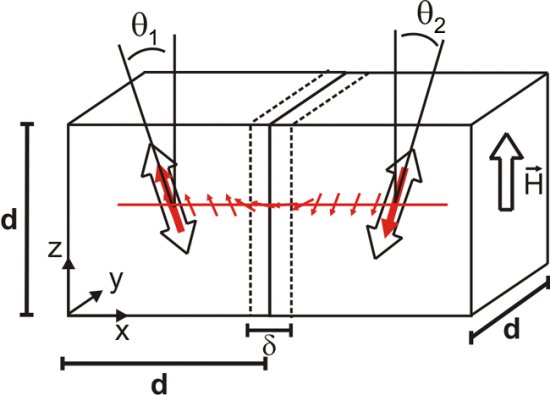The study of irreversible switching processes via δm-plots is a common experimental technique to assess intergrain interactions in nanoscaled magnetic materials. Theoretical predictions, on the other hand, of the influence of grain size, texture and field direction on the shape and absolute values of δm-plots are missing. In this paper direct intergrain exchange coupling is evaluated in a combined numerical/analytical approach for a model system of two coupled, hard magnetic grains. The influence of grain size and easy axis orientation on the outcome of a δm-analysis is determined quantitatively. As expected from the short range characteristic of direct exchange coupling, the field-integrated δm-signal decreases with increasing grain size. However, whereas directly coupled grains with parallel easy axis orientation possess large positive δm -values, for increasing misorientation angle the integrated δm-signal reduces and reaches even negative values. Such an effect of negative δm is so far only associated with indirect magnetostatic interactions. In a statistical extension of the model, grain ensembles with Gaussian distribution of their texture axis along one well defined sample direction are examined. The shape, width and height of the calculated δm-plots bear characteristic features known from experimental studies on nanocrystalline, well textured SmCo5 films.

The study of irreversible switching processes via δm-plots is a common experimental technique to assess intergrain interactions in nanoscaled magnetic materials. Theoretical predictions, on the other hand, of the influence of grain size, texture and field direction on the shape and absolute values of δm-plots are missing. In this paper direct intergrain exchange coupling is evaluated in a combined numerical/analytical approach for a model system of two coupled, hard magnetic grains. The influence of grain size and easy axis orientation on the outcome of a δm-analysis is determined quantitatively. As expected from the short range characteristic of direct exchange coupling, the field-integrated δm-signal decreases with increasing grain size. However, whereas directly coupled grains with parallel easy axis orientation possess large positive δm -values, for increasing misorientation angle the integrated δm-signal reduces and reaches even negative values. Such an effect of negative δm is so far only associated with indirect magnetostatic interactions. In a statistical extension of the model, grain ensembles with Gaussian distribution of their texture axis along one well defined sample direction are examined. The shape, width and height of the calculated δm-plots bear characteristic features known from experimental studies on nanocrystalline, well textured SmCo5 films.
